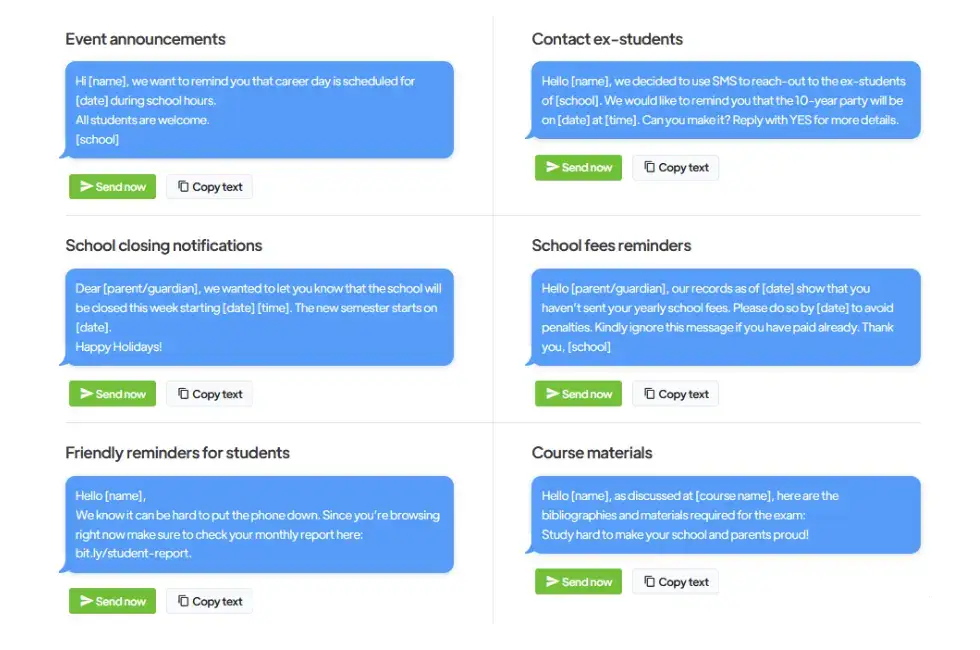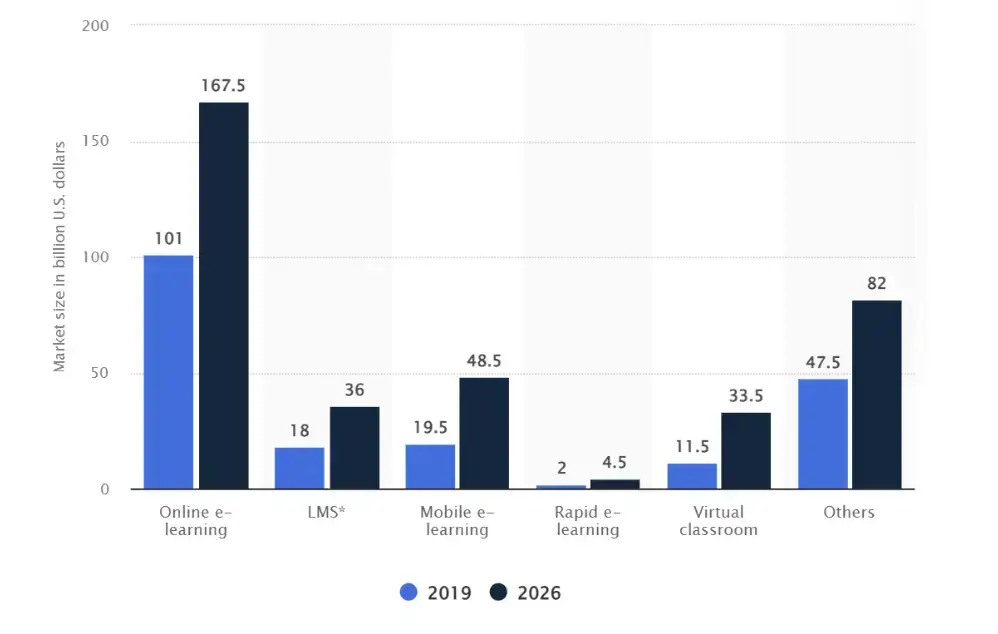Table of Contents
Did you know that the vast majority of businesses prioritize online training and upskilling, and almost 50% of L&D specialists expect an increase in their budget?
The global eLearning market was worth $200 billion in 2019. These numbers are boggling enough for everyone to notice. However, the trend in this industry is not going to stop here. By 2026, industry analysts expect the global online learning market to reach almost $400 billion.
Size of the global eLearning market in 2019 and 2026
The impressive rise of eLearning worldwide calls for developing strategies for streamlining course design and increasing efficiency. This makes the topic of instructional and post-instructional strategies particularly important. They can be used to enhance learning, increase retention, and improve motivation.
To help enhance the effectiveness of your online course design and training, we have collected the best eLearning strategies and tips you can apply during and after your online course. We will also touch upon the ways top-notch technology can optimize the course creation and instruction process. By the end of this article, you’ll know how to improve learners’ engagement and motivation, ensuring the success of your educational project.
Let’s get started by discussing the basic concepts.
Table of contents
The Four Learning Types Explained
Your eLearning course needs to cater to the needs of various learners. Although usually a course attracts a blend of learning types, here are the four most common types you have to consider when designing your educational materials following the VARK Model:
General Elearning Development Strategies To Boost The Efficiency Of Instructional Design
If you are designing an eLearning course, you will need to make sure it is as effective as possible. Here are some instructional design strategies that can help:
Specify your target audience
Identifying your target audience is a critical step to ensuring your course is engaging and matches the needs of learners. Failing to distinguish your learner’s persona correctly is likely to result in impaired learner motivation and engagement, and hence inefficiency of your effort.
So, there are some compulsory questions you have to start with when setting your foot on course development. Who will be learning the content? What are their educational background and learning abilities? What are their habits and interests? What’s their level of experience? What knowledge have they already acquired, and what are the areas that will need further expansion? What are their expectations for the training and its outcomes?
And most importantly, why are they opting to take the course? This central question leads us to the next step of course development: identifying the purpose and the desired outcomes.
Set the learning objectives
Knowing who your learners are and what skills or knowledge they need allows you to set specific learning objectives for your course. This is a crucial stage of course development that will guide you throughout the whole process of course creation. It will help ensure that all materials are aligned with the learning purpose and desired results.
Keep in mind that you must make the practical benefits of completing the course clear to learners. What specific set of knowledge or skills will they acquire? What tasks will they be able to solve? The awareness of these details will keep learners highly motivated, engaged, and interested.
At the same time identifying course objectives will allow you to structure your course and materials effectively, so you can be sure you have applied the best approach that perfectly responds to the needs and expectations of your target audience.
Identify the learning style and content
When considering how to structure a course, you should first identify the learning style of your target audience. Are they visual, auditory, reading and writing, or kinesthetic learners?
Based on this information, you will be able to identify the content that will be most efficient for learners. A good eLearning design covers all the key learning points and includes a mix of content types.
Specify the technology requirements of your course
You can create your course using an all-in-one dedicated platform, such as LearnWorlds, which caters to all your training-specific needs. Your next step is to select a tool where you can virtually meet learners and conduct the instruction. The most common options are Zoom, Microsoft Teams, and Google Classroom. Luckily, modern Learning Management Systems (LMS) offer built-in course players and support easy integrations with the different video conferencing platforms available, so you can offer a seamless experience to your learners.
Communication is key to student success. You need to keep your students informed about what is going on in the course, when assignments are due and how to get help.
How can you make sure you are there for learners when they need your support? The best way is to provide multiple channels for effective communication with learners. Emails are an excellent way to communicate with your learners. Sometimes, however, you will need a more direct yet discreet way to deliver your message to learners. This is where SMS comes into play as a reliable universal option that does not require an internet connection and additional installation.
A text messaging platform can offer functionalities specifically tailored to schools and training purposes. You can schedule SMS reminders, urgent rescheduling, and updates. In addition, such a solution provides for grade and attendance verification and allows users to send bulk text messages online.
This saves you from having to send individual text messages through your mobile phone manually!

Develop a tactical plan
Now that you have your entire learning objectives and strategy outlined, it is time to develop a tactical plan. When doing so, you have to consider the projects, individual tasks, dependencies, resource allocation, and the timeline for creating and completing your eLearning course.
There are various project management tools like Asana, Trello, and Teamwork that you can utilize to facilitate planning the scope of work, tracking progress, and optimizing performance.
10 Instructional eLearning Strategies
Let’s now move on to some effective strategies you can apply during the instruction process.
The use of instructional online learning strategies can help you create engaging and interactive learning experiences that are more effective than traditional classroom training methods.
Below are ten instructional strategies that you can use in your next online learning course to maximize engagement and retention.
1. Implement a microlearning approach
Microlearning can be used in any course to help learners retain information better and learn more efficiently by presenting the new information in small chunks taking up to 10 minutes. This will increase the learning efficiency by 17% as compared with courses of a longer duration.
2. Support on-the-go learning by utilizing mobile learning technologies and platforms
You can use the learning on-the-go approach for many different types of training and development. It’s easily adapted to the lifestyle and individual schedule of learners, letting them progress at their own pace and access and interact with the content on the go.
3. Promote peer learning
Build an online learner community to encourage engagement and foster collaboration. It’s also an excellent way for learners to share their knowledge and experiences, which can help you identify opportunities for improvement in your instructional design.
4. Just play it
Implement gamification and role-play to increase learners’ motivation. The goal of gamification is to create an engaging learning environment that encourages your audience to learn more and faster and retain new information better. You can apply this strategy to any type of training course.
5. Put social instincts to work
Social learning models are often used to help learners practice and reinforce the concepts they are learning. You can also use them to help learners connect with their group mates and share best practices. Using webinars and social media interactions is a great way to provide real-time learning experiences above and beyond the classroom.
6. Go real
Use case studies, real-world examples, and simulations. This will help learners make connections between what they are learning in your course and the notions they understand, thereby fitting the new content into an already established network of knowledge.
For example, if your tutorials are on financial management, you could talk about how things like budgeting and saving money work in real-life situations (e.g., buying groceries).
7. Throw the ball to your learners
Use classroom shifting techniques to adopt learner-centered approaches and increase involvement. Letting learners take over will undoubtedly increase their engagement and provoke their interest.
For instance, you can let learners manage part of the “classroom” process by assigning them small individual tasks related to the next-lesson topic and allowing them to do the “warm-up” and share what they’ve come up with.
8. Foster personalized learning
Tailoring content to the individual learner’s needs and interests can go a long way in increasing course efficiency. You can implement an AI-enabled tool that features search and personalization engines providing the best-tailored answer to a learner’s question along with personalized feedback.
9. Implement a hands-on approach through on-the-job training (OJT)
On-the-job training allows employees to learn at their own pace while they are performing their job duties. This means they will develop a better understanding of the subject matter than if they were just reading about it. OJT is particularly relevant to employee onboarding and corporate training.
10. Encourage problem-solving activities and games
Use problem-solving activities to make your learners more engaged. You can create your own scenarios. Also, you can use contests and rewards. This will increase motivation by 26%.
For example, if you are teaching about workplace safety, you could ask learners to imagine they had an injury at work. Then show them how to deal with the situation by applying the skills they have learned. Thereby, learners will develop the ability to think creatively and solve real-life problems.
Post-instructional eLearning Strategies
The key to post-instructional strategies is to ensure the learner can apply what they have learned. Here are some proven strategies you can rely on
1. Quiz learners and provide them with feedback
Quizzes are often used at the end of each section of material, while tests are given at the end of each module or lesson within an online course. An LMS enables you to take advantage of online gradebooks, so both the instructor and the learners gain a clear and detailed view of learning progress and the fields that need further improvement.
2. Ask learners for feedback after each session and course
Another way to measure whether learners understand what you are trying to teach is by soliciting feedback from them after they complete an activity or quiz. If they do not seem confident in their answers, ask if there is anything else they would like help with before moving on to something else in the lesson plan.
You can also take advantage of a text messaging platform to collect feedback using customizable survey templates and analyze it. Letting learners use different channels to share their opinion, suggestions, and pain points will increase your chances of getting and taking into account everyone’s response.
3. Give learners follow-up assignments
The purpose of assigning follow-up work is to make sure that learners understand key concepts. This could be as simple as asking learners to write down the key points from a lecture or review an activity they did. It could also involve asking them to complete an assignment, such as researching a topic or creating a presentation on their own.
4. Develop complementary interactive content
This is a great way to enhance the learner’s experience after they complete a module or the whole course. Creating a short video related to the course content can help you achieve this goal. You could also create a guide that gives more information related to key course topics.
5. Measure the contribution of eLearning
Evaluate your eLearning program to determine how well it is meeting its goals and objectives. Some organizations use surveys, focus groups, and interviews to assess the effectiveness of their eLearning programs. Others measure performance in specific areas, such as knowledge retention or time spent on learning activities.
Note that you have to make sure to incorporate this valuable data into the development of your subsequent courses and training.
10 Pro Tips For Instructional Design Strategies
You can combine many instructional methodologies to create eLearning courses. The key is to use a variety of instructional design strategies and implement them in a way that will engage learners and help them retain the information. Here are some of the most effective instructional design tips for creating engaging eLearning courses.
1. Create a curriculum that matches your goals and learners’ needs
This is an essential part of designing an online course. Decide the content and activities that will be most effective in engaging your learners and helping them achieve their goals. Then, determine how long each section should take and how much time each activity will require.
2. Use forms
Forms are a great way of engaging both learners and website visitors. You can get your audience to interact with you, ask questions, and take part in your online courses. The best thing about using forms is that you can use them in any subject area.
3. Use simple interactions
The best way to make sure that your eLearning content is successful is to create engaging, easy-to-access, and easy-to-understand content. Your learners should know what they need to do next when they are working through your course.
Avoid long videos as they can easily bore learners. Instead, use short videos that learners can easily understand without getting tired too quickly. Also, avoid using long paragraphs in text boxes. It is difficult for learners to read them all at once and try to memorize all the details.
4. Incorporate video
You can use visuals, like infographic content, videos, multimedia, and podcasts, to simplify complex concepts and make them more memorable, making the learning process easier for the student. Let’s say you are teaching a course on how to use an accounting system. A video showing how to record a transaction in the system will let students actually see it happen.
So, incorporating video in your course design is an essential part of creating a high-quality learning experience. Luckily, there are many online tools to craft your educational video content.
5. Use a correct color scheme
Color enhances the quality of your eLearning content and improves the learning experience. Using the right colors in your eLearning course can make it more engaging for learners and make the learning process easier.
For instance, neutral colors such as black, white, gray, and brown will make your course look professional without distracting learners’ attention. Also, contrasting colors make content stand out, which improves readability and comprehension.
6. Use closed captions and text transcripts
Closed captions are subtitles that appear on-screen at the same time as the audio. Closed captions and text transcripts are a great way to make your eLearning content more accessible to learners.
7. Use clean and bold fonts
Choose fonts that are easy to read without the need for intense zooming in, and make sure not to mix different fonts in one area. If you have to use a font with small letters, make sure there is enough space between letters so that users can easily distinguish one from another and read them correctly. Use clear typefaces such as Verdana or Arial, which are popular choices among designers as they are readable even at small sizes.
8. Use simple navigation and alt titles
Make sure that your navigation is clear and straightforward. You can use a combination of tabs, drop-down menus, and hyperlinks to help guide your users through your course.
9. Omit using Flash
Flash animation is no longer necessary for creating interactive online educational content because:
Use HTML5 instead. It is SEO-friendly, loads fast, and works great on mobile devices. Designers have more flexibility than ever before to create beautiful, interactive courses.
10. Use simple and clear language
You should write your courses in a way that is easy to understand. Keep sentences short and sweet. Avoid complex words where simple ones would do. This helps people process information more efficiently, leading to better learning outcomes.
Are You Ready To Improve Your Online Courses’ Efficiency?
Implementing the proven strategies and tips we discussed will enable you to engage learners and offer outstanding learning experiences. When done well, an eLearning course can create an efficient learning environment supporting and empowering your learners to expand their knowledge and skills faster, better, and more easily.
Remember that you are not alone in your effort to respond to your audience’s needs and deliver helpful and memorable educational content. Modern eLearning authoring tools bring various exciting ways to blend instructional methods and media, allowing course creators to develop instructional materials that resonate with the target audience.
So, it is time to unleash your imagination and creativity, combining the instructional and post-instructional strategies above, and help your learners go through their educational journey and achieve their learning goals!

Alexa Lemzy
Alexa Lemzy is a professional digital marketer and dedicated business blogger at TextMagic. She writes mainly about strategies for business growth, mobile marketing, and online communication.


